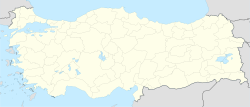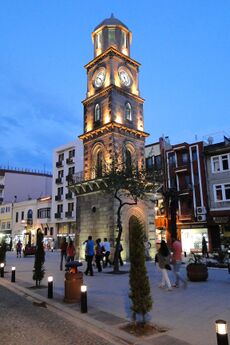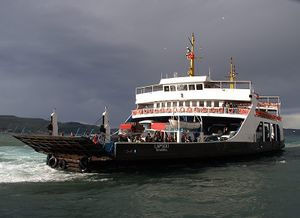چنققلعه
چنققلعه | |
|---|---|
 | |
 تقع چنققلعه على الجانب الآسيوي للمدخل الجنوبي لمضيق الدردنيل من بحر إيجة. | |
تقع چنققلعه على الجانب الآسيوي للمدخل الجنوبي لمضيق الدردنيل من بحر إيجة. | |
| الإحداثيات: 40°09′21″N 26°24′49″E / 40.15583°N 26.41361°E | |
| البلد | |
| المحافظة | چنققلعه |
| الحكومة | |
| • العمدة | Ülgür Gökhan (ح.ش.ج.) |
| المساحة | |
| • المدينة | 938 كم² (362 ميل²) |
| التعداد (2008)[1] | |
| • المدينة | 119٬207 |
| • الكثافة | 127/km2 (330/sq mi) |
| • Urban | 90٬653 |
| مفتاح الهاتف | (+90) 286 |
| الموقع الإلكتروني | http://www.canakkale.bel.tr |
مدينة چناق قلعة هي عاصمة محافظة چناق قلعة يبلغ عدد سكانها 90,653 نسمة. تقع چنققلعه على الجانب الآسيوي للمدخل الجنوبي لمضيق الدردنيل من بحر إيجة.
Çanakkale is the nearest major urban centre to the ancient city of Troy, which (together with the ancient region of the Troad) is also located inside Çanakkale Province. The wooden horse from the 2004 movie Troy is exhibited on the Çanakkale waterfront.
Today Çanakkale is the main base for visits to the ruins of Troy and to the First World War cemeteries at Gallipoli. Particularly around 18 March and 25 April (ANZAC Day) when there are major celebrations of the two different interpretations of the events of the war the town fills with visitors and every hotel room is likely to be booked up for months in advance.
Every year Çanakkale is the finishing point for a demanding swim across the Dardanelles from Eceabat. This event reproduces the swim taken by Lord Byron in 1810. Byron himself was reproducing Leander's legendary swim from Sestos to Abydos in the story of Hero and Leander.
Çanakkale Airport (CKZ) is 3 km from the city centre. AnadoluJet and Borajet have daily flights from Istanbul and Ankara. Intercity buses run to Bursa, Istanbul and Izmir. In 2022 the 1915 Çanakkale Bridge opened just to the south of Çanakkale to facilitate and speed the crossing of the Dardanelles.
Name
Çanakkale was originally the site of an Ottoman fortress called Ḳalʿa-i Sulṭānīye (تركية عثمانية: قلعهٔ سلطانیه; تركية: Sultaniye Kalesi). From the late 17th century it became known for its glazed Çanakkale ceramics, compared by the traveler Richard Pococke to Delftware,[3] hence the later name Çanak Kalesi "Pottery Castle". This was adopted as the official term for the town in 1890, although already in use a century earlier.[4]
The Greek-Byzantine name for Çanakkale was Dardanellia,[5] from which the English name Dardanelles is derived. Many accounts by 19th-century visitors to the town refer to it as Dardanelles.
From around 1920, the British began to call Çanakkale, 'Chanak' and 'Kale Sultanie' in their reporting.[6]
History
Prehistory and ancient history
The first inhabitants of the area lived on the Biga Peninsula in the Last Chalcolithic Age c. 6,000 years ago. However, very little is known about their identity and lifestyle. According to some excavations and research, the earliest settlements in the area were established at Kumtepe. Kumkale is thought to have been established in 4000 BC and Troy between 3500 and 3000 BC.
Aeolian Greeks settled here in the 8th century BC and quickly established trading colonies. The region came under the control of the Lydians in the 7th century BC and under the control of the Persians in the 6th century BC. Aeolis fell under the control of the Ancient Macedonian army after Alexander the Great defeated the Persians beside the Granicus River in the Battle of the Granicus on his way to Asia in 334 BC. The region came under the government of the Kingdom of Pergamon in the 2nd century BC.
The western part of the Biga Peninsula where ancient Troy is situated used to be called Troas (the Troad). The important settlement of Alexandria Troas was an important free port and trade centre in Roman times. In the 2nd century AD, the region was attacked by Goths from Thrace. During the 7th and 8th centuries, Arabs hoping to attack Constantinople passed through the strait several times and reached as far as Sestos
Ottoman era
At the start of the 14th century the Karasids under Demirhan Bey controlled the Anatolian side of the strait. The Ottomans first gained control of Gallipoli in 1367. In 1462 Mehmed II had the Kale-I Sultaniye fortress built on the site now occupied by Çanakkale - it takes it names from the fact that one of the Sultan's sons had collaborated in its construction.[4] Kale-I Sultaniye was built at the narrowest point of the Dardanelles and, together with the fort of Kilitbahir on the opposite side, provided effective in controlling traffic through the strait. The two forts were quickly dubbed "The Castles", and a town developed to the north-east of Kale-I Sultaniye.
From the late 15th century onwards, Jewish refugees expelled from Spain settled in Çanakkale and formed a sizeable community which thrived by supplying local shipping with provisions and acting as consular agents for many European nations. Into the late 19th century the Jewish community retained Spanish as a mother-tongue. Some 1,805 Jews were registered there in 1890, out of a population of 10,862, the rest being Muslims (3,551), Orthodox Greeks (2,577), Armenians (956) and assorted foreigners (2,173).[4]
Twentieth century
In 1915, during the First World War, the Britain and France attempted to secure the Dardanelles with a view to capturing Constantinople. What is known in the West as the Gallipoli Campaign, or the Dardanelles Campaign, is referred to as the Battle of Çanakkale (تركية: Çanakkale Savaşı) in Turkey. In March 1915 the Royal Navy failed to force the Dardanelles and suffered severe losses. In a series of operations, HMS Triumph, HMS Ocean, HMS Goliath, HMS Irresistible and the French battleship Bouvet were all sunk. The French submarine Q84 Joule and the Australian submarine AE2 were also destroyed and several other important ships were crippled. Most of the damage was inflicted by mines, though a German U-Boat and Turkish small craft also contributed.
In 1920 the city was estimated to have a population of approximately 22,000. A busy port, it was a stopping point for vessels traveling through the Strait, as it had been in the ancient past although the British who passed through described it as lacking good quality accommodation or resources. Goods exported from the port included wine, hides, pottery, ceramic tiles and grain.[6]
Attractions
In Çanakkale
In Çanakkale town the old Kale-i Sultaniye is now called Çimenlik Kalesi and is open to the public as a military museum and art gallery. It also contains a replica of the mine-layer Nusret[7]which was used to relay mines removed from the Dardanelles by the Allied forces during the First World War.[8]
A late 19th-century clocktower acts as a signpost for the older part of town where narrow streets are filled with bars, cafes and hotels. Also in this older part of the town is a relatively new Kent Müzesi (City Museum) which lays out the more recent history of the town.[9] (The contents of the old Çanakkale Archaeology Museum have been moved to the new Troy Museum.)
The most attractive part of town in the evenings is the wide'waterfront promenade where the wooden horse created for the film Troy starring Brad Pitt and Orlando Bloom can be seen. Many cafes and restaurants line up here to take advantage of the view of the Dardanelles.[بحاجة لمصدر]
Around Çanakkale
Regular ferries pass back and forth between Çanakkale and Kilitbahir where the second castle built to guard the Dardanelles is open to visitors.[10]
All the tour operators in Çanakkale offer tours of the Gallipoli Battlefields and Troy, sometimes on the same day. It is easy to reach Troy by minibus from Çanakkale although exploring the Battlefields without a private car is not so easy. [11]
In summer it is also easy to reach Gökçeada, one of only two inhabited Aegean islands that belong to Turkey, by ferry from Çanakkale. In winter bad weather may prevent the ferries from sailing. [12]
Çanakkale Ceramics
From the 17th century onwards Çanakkale appears to have had a thriving ceramics industry which seemed to have expanded as its competitors in İzmik and Kütahya went into decline. The produce of the kilns was, however, less sophisticated than that of the other two major centres, and by the late 19th century it appears to have been producing much pottery specifically aimed at the tourist market. Until recently the folksy quality of much Çanakkale ware, in particular its rather clumpy animal and plant-shaped pots, tended to be sneered at. However, these same pieces are now very popular with collectors.[13]
Climate
Çanakkale has a Mediterranean climate (Köppen: Csa or Trewartha: Cs) with hot, dry summers and cool, wet winters.
| أخفClimate data for Çanakkale (1991–2020, extremes 1929–2021) | |||||||||||||
|---|---|---|---|---|---|---|---|---|---|---|---|---|---|
| Month | Jan | Feb | Mar | Apr | May | Jun | Jul | Aug | Sep | Oct | Nov | Dec | Year |
| Record high °C (°F) | 20.0 (68.0) |
21.3 (70.3) |
27.3 (81.1) |
30.8 (87.4) |
38.9 (102.0) |
36.8 (98.2) |
39.0 (102.2) |
39.7 (103.5) |
35.9 (96.6) |
31.8 (89.2) |
26.2 (79.2) |
22.9 (73.2) |
39.7 (103.5) |
| Mean daily maximum °C (°F) | 9.8 (49.6) |
10.5 (50.9) |
13.1 (55.6) |
17.4 (63.3) |
23.0 (73.4) |
28.4 (83.1) |
31.4 (88.5) |
31.5 (88.7) |
26.7 (80.1) |
21.1 (70.0) |
16.1 (61.0) |
11.5 (52.7) |
20.0 (68.0) |
| Daily mean °C (°F) | 6.5 (43.7) |
7.0 (44.6) |
9.1 (48.4) |
12.8 (55.0) |
18.0 (64.4) |
22.9 (73.2) |
25.8 (78.4) |
26.0 (78.8) |
21.6 (70.9) |
16.8 (62.2) |
12.3 (54.1) |
8.3 (46.9) |
15.6 (60.1) |
| Mean daily minimum °C (°F) | 3.6 (38.5) |
4.0 (39.2) |
5.7 (42.3) |
9.0 (48.2) |
13.7 (56.7) |
17.9 (64.2) |
20.8 (69.4) |
21.2 (70.2) |
17.1 (62.8) |
13.1 (55.6) |
8.9 (48.0) |
5.5 (41.9) |
11.7 (53.1) |
| Record low °C (°F) | −11.0 (12.2) |
−11.5 (11.3) |
−8.5 (16.7) |
−1.6 (29.1) |
2.3 (36.1) |
6.6 (43.9) |
11.2 (52.2) |
9.4 (48.9) |
5.9 (42.6) |
0.4 (32.7) |
−7.0 (19.4) |
−10.5 (13.1) |
−11.5 (11.3) |
| Average precipitation mm (inches) | 78.6 (3.09) |
76.3 (3.00) |
66.0 (2.60) |
49.0 (1.93) |
32.1 (1.26) |
27.3 (1.07) |
12.9 (0.51) |
6.8 (0.27) |
24.2 (0.95) |
67.5 (2.66) |
79.2 (3.12) |
100.4 (3.95) |
620.3 (24.42) |
| Average precipitation days | 11.27 | 10.70 | 10.47 | 8.83 | 6.40 | 4.97 | 1.90 | 1.20 | 3.87 | 7.10 | 8.77 | 11.63 | 87.1 |
| Mean monthly sunshine hours | 93.0 | 118.7 | 164.3 | 207.0 | 272.8 | 309.0 | 341.0 | 322.4 | 249.0 | 179.8 | 117.0 | 86.8 | 2٬460٫8 |
| Mean daily sunshine hours | 3.0 | 4.2 | 5.3 | 6.9 | 8.8 | 10.3 | 11.0 | 10.4 | 8.3 | 5.8 | 3.9 | 2.8 | 6.7 |
| Source: Turkish State Meteorological Service[14][15] | |||||||||||||
Education
Within the boundaries of the city there are 13 high schools and a college. Çanakkale Onsekiz Mart University has 12 faculties, four institutes, nine four-year colleges and 14 vocational schools and serves more than 52,000 students. Thirty percent of the city's population are college graduates.
Notable people from Çanakkale
- Nuri Bilge Ceylan (film director)
- Metin Erksan (film director)
- Tevfik Rüştü Aras (Turkish foreign minister)
- Zeynep Bastık (singer)
- Mustafa Tutkun (humanitarian activist)
- Güney Dal (writer)
International relations
Twin towns — sister cities
انظر أيضاً
References
- ^ معهد الإحصاء التركي، تم الوصول له في 9. نوفمبر 2009
- ^ "USGS detail on Detroit". Retrieved 2007-02-18.
- ^ "Canakkale Ceramics | CERAMOPOLIS" (in الإنجليزية الأمريكية). Retrieved 2022-10-02.
- ^ أ ب ت J.M.Cook, The Troad:An Archaeological and Topographical Study, Clarendon Press Oxford 1973 p.53, and n.3.
- ^ Régis Darques, Salonique au XXe siècle: De la cité ottomane à la métropole grecque, editions CNRS 2000 p. 299.
- ^ أ ب Prothero, G.W. (1920). Anatolia. London: H.M. Stationery Office.
- ^ says, Huseyin (2013-03-17). "Lest We Forget: The Minelayer Nusret" (in الإنجليزية). Retrieved 2022-10-02.
- ^ "ÇANAKKALE". www.turkeyfromtheinside.com. Retrieved 2022-10-02.
- ^ "ÇANAKKALE". www.turkeyfromtheinside.com. Retrieved 2022-10-02.
- ^ "KİLİTBAHİR". www.turkeyfromtheinside.com. Retrieved 2022-10-02.
- ^ "ÇANAKKALE". www.turkeyfromtheinside.com. Retrieved 2022-10-02.
- ^ "GÖKÇEADA". www.turkeyfromtheinside.com. Retrieved 2022-10-02.
- ^ "Canakkale Ceramics | CERAMOPOLIS" (in الإنجليزية الأمريكية). Retrieved 2022-10-02.
- ^ "Resmi İstatistikler: İllerimize Ait Mevism Normalleri (1991–2020)" (in التركية). Turkish State Meteorological Service. Retrieved 24 April 2021.
- ^ @yturker (1 August 2021). "17.00 Hava Sıcaklıkları: Cizre 45.1,..." (Tweet) – via Twitter.
{{cite web}}: Cite has empty unknown parameter:|dead-url=(help)
- Encyclopædia Britannica Eleventh Edition s.v. Dardanelles (town).
External links
- Çanakkale (in Turkish)
- Çanakkale Haberleri (in Turkish)
- Pictures of the town and sub-galleries to major sights
- An overview of memorials, cemeteries and relics of the Gallipoli campaign, in Turkish known as the Çanakkale wars.
التاريخ
التوأمة
انظر أيضا
- معركة گاليپولي
- گوزليالي، بلدة مجاورة
- أزمة چناق
الهامش
- Encyclopedia Britannica Eleventh Edition s.v. Dardanelles (town).
وصلات خارجية
| Canakkale
]].- CS1 الإنجليزية الأمريكية-language sources (en-us)
- CS1 التركية-language sources (tr)
- Pages using gadget WikiMiniAtlas
- Short description is different from Wikidata
- Pages using infobox settlement with unknown parameters
- Articles containing التركية العثماثية (1500-1928)-language text
- Pages using Lang-xx templates
- مقالات ذات عبارات بحاجة لمصادر
- محافظة چنققلعه
- مدن تركيا
- منطقة مرمرة
- Coordinates on Wikidata
- مستوطنات ساحلية في تركيا
- موانئ بحر إيجة في تركيا










